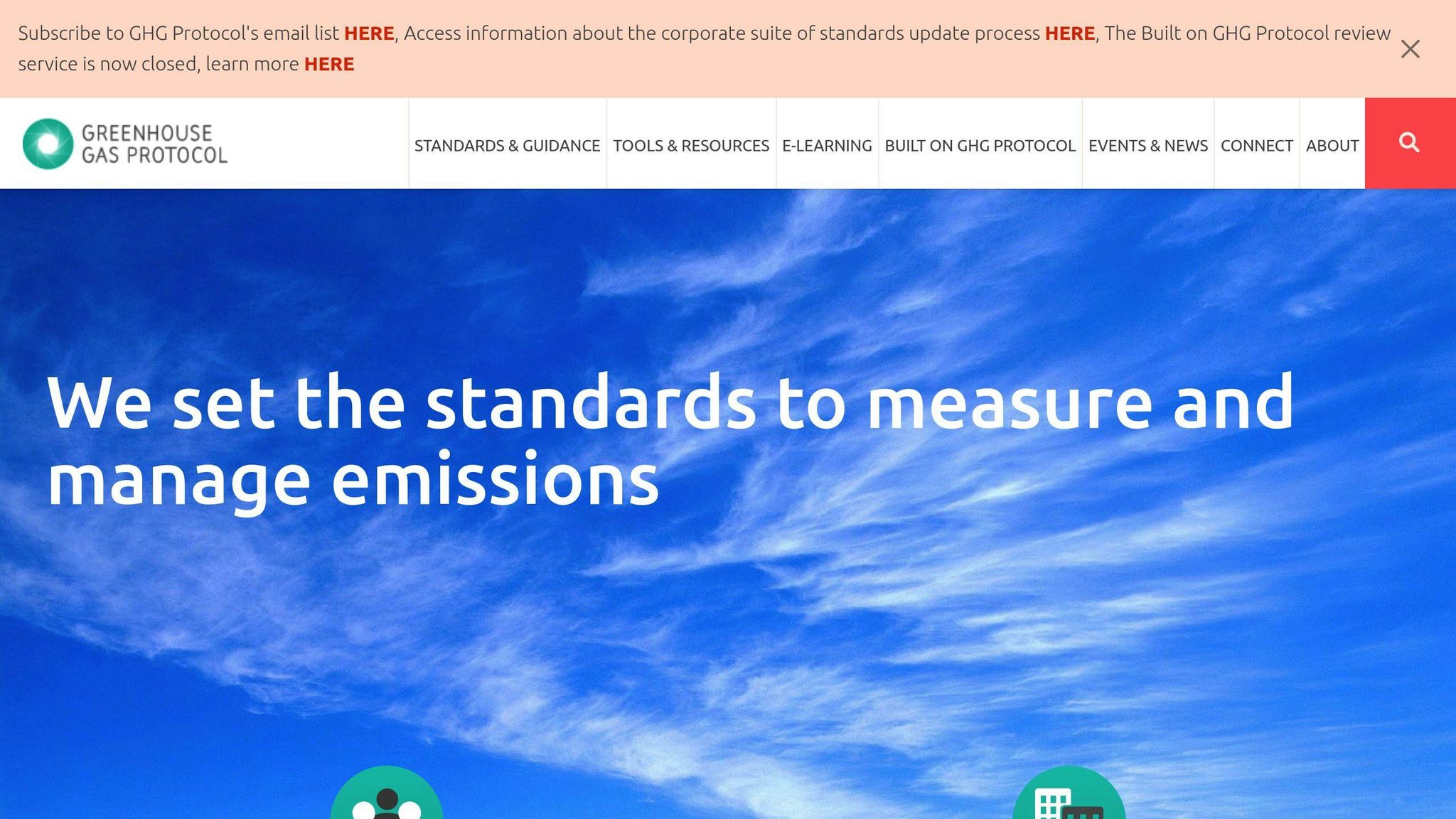Want to cut your company's carbon footprint? Don't overlook employee commutes. Here's what you need to know about Scope 3 Category 7 emissions:
- It's all about greenhouse gases from workers traveling to and from work
- Can be 10-15% of a company's Scope 3 emissions
- Includes cars, public transport, and even e-scooters
- Not the same as business travel (that's Category 6)
Why care?
- Helps spot emission hotspots
- Improves supplier sustainability
- Drives smarter decisions
- Boosts employee engagement
How to tackle it:
- Push public transit
- Set up carpools
- Make walking and biking easier
- Offer flexible work options
| Method | How it works |
|---|---|
| Surveys | Ask employees about commutes |
| Estimates | Use typical patterns |
| Smart platforms | Tech-driven management |
Remember: 82% of employees say they'd use greener options if given the chance. So why wait? Start greening those commutes now!
Related video from YouTube
What are Scope 3 Category 7 Emissions?
Scope 3 Category 7 emissions are the greenhouse gases from employee commutes in vehicles not owned by the company. This covers:
- Cars
- Public transport
- Planes
- Ferries
- E-scooters
It's NOT business travel - that's Scope 3 Category 6.
Employee Commuting Emissions Explained
These are indirect emissions in a company's value chain. For many businesses, especially those with lots of employees, commuting can be a BIG part of their Scope 3 emissions.
Transportation Types
| Transport | Examples |
|---|---|
| Personal | Cars, motorcycles |
| Public | Buses, trains |
| Active | Bikes, walking |
| Shared | Carpools |
| Other | Ferries, e-scooters |
How It's Different
Scope 3 Category 7 emissions are unique:
- Not company-owned
- Happen daily
- Employee's choice
- Indirect impact
Understanding these differences is key for companies tackling their carbon footprint. By addressing commuting, businesses can make a real dent in their environmental impact.
Why Employee Commuting Emissions Matter
Commuting emissions are a big deal for companies. Here's why:
They're a Major Part of Emissions
Commuting can be a huge chunk of a company's carbon footprint:
- 10-15% of Scope 3 emissions come from commuting
- For some employees, commuting is 98% of their work-related carbon footprint
- 62% of commutes are solo car trips, which are carbon-heavy
Tackling these emissions can make a real dent in a company's overall impact.
They're Crucial for Sustainability Goals
Companies can't ignore commuting if they want to go green:
- Scope 3 emissions (including commuting) can be up to 70-80% of total emissions
- Only half of big companies measure how remote work affects emissions
- Cutting commute emissions is often low-hanging fruit for sustainability
| Action | Emission Reduction |
|---|---|
| Adding one car passenger | 50% |
| Using shared shuttles | 45% vs. solo driving |
They Affect Employee Satisfaction
Addressing commuting isn't just good for the planet - it's good for workers:
- Green efforts can boost job satisfaction
- Top talent expects companies to care about the environment
- Better commutes can mean less stress and more productivity
Take Cleveland Clinic, for example. They:
- Offer clean vehicle incentives
- Promote public transport use
- Give carpool parking discounts
These programs show employees the company cares about them and the planet.
How to Calculate Employee Commuting Emissions
Want to know your company's carbon footprint from commuting? Here's how to figure it out:
Calculation Methods
You've got three main options:
- Fuel-based: Measure fuel used and apply emission factors.
- Distance-based: Collect commuting data and use emission factors.
- Average-data: Use national averages to estimate emissions.
What You Need
To get it right, you'll need:
- How employees get to work
- How far they travel
- How often they commute
- What kind of cars they drive (if applicable)
- Work-from-home info (if relevant)
Data Collection Hurdles
Getting accurate info can be tough:
- Employees might ignore surveys
- Work-from-home policies can mess with data
- Some transport modes lack good emission data
To tackle these issues:
- Give people a reason to fill out surveys
- Use samples to estimate overall patterns
- Team up with local transport folks for better data
"To calculate emissions from employee commuting, you'll need the following data: Modes of transportation, commuting data, teleworking data (optional), and emission factors." - Zeroe Official Site
Here's a quick look at the process:
| Step | What to Do |
|---|---|
| 1. | Gather commute info |
| 2. | Use emission factors from trusted sources |
| 3. | Crunch the numbers |
| 4. | Convert to CO2 equivalent |
| 5. | Look for ways to cut emissions |
sbb-itb-919600f
Ways to Lower Employee Commuting Emissions
Want to slash your company's commuting emissions? Here's how:
Push Public Transit
Give your team free bus or train passes. It works. One company saw each employee cut 20 pounds of CO2 daily by ditching their car.
Set Up Carpools
Carpooling cuts emissions in half when two people share a ride. Here's the playbook:
1. Create a carpool sign-up system
2. Give carpoolers prime parking spots
3. Offer emergency rides home
One company's car club boosted cycling to work by 38%. Not bad.
Make Walking and Biking Easy
To get people moving:
- Install secure bike storage
- Add showers and changing rooms
- Offer no-interest bike loans
Imperial College London tried this. Result? 65% of trips became active travel.
Embrace Flexible Work
Working from home cuts commutes. If remote-capable workers stayed home half the time, it'd be like taking all of New York State's workers off the road.
| Strategy | Impact |
|---|---|
| Free transit passes | Up to 20 lbs CO2 cut per person, daily |
| Carpooling | Halves emissions for shared rides |
| Promote active travel | 65% of trips in one test |
| Half-time remote work | Like removing NY State's workforce from commuting |
Reporting Employee Commuting Emissions
Tracking employee commuting emissions is tough, but it's crucial for cutting your company's carbon footprint. Here's how to nail it:
GHG Protocol: Your Reporting Roadmap

The Greenhouse Gas (GHG) Protocol is the gold standard for emissions reporting. Employee commuting? That's Scope 3, Category 7.
To stick to GHG Protocol rules:
- Use metric tons of CO2 equivalent
- Be relevant, complete, consistent, transparent, and accurate
- Include all 15 Scope 3 categories (unless you've got a good reason not to)
5 Tips for Crystal-Clear Reporting
1. Get the nitty-gritty details
Ask employees about their commutes:
- How far?
- What type of transport?
- How often?
2. Nail those emission factors
Find the right numbers for each transport type. Check out:
- National environmental agencies
- IPCC (Intergovernmental Panel on Climate Change)
3. Show your homework
Be upfront about:
- Where you got your data
- How you crunched the numbers
- Any guesses you had to make
4. Get a second opinion
Third-party verification? It's like a seal of approval. Start small if you need to.
5. Always be improving
Emissions reporting isn't a one-and-done deal. Focus on your biggest impact areas and keep refining.
Conclusion
Employee commuting is a big deal for companies trying to cut carbon. Here's why:
- It's part of Scope 3, Category 7 in the GHG Protocol
- It can be huge - Sun Microsystems found it was 98% of their work-related carbon footprint
- Most employees (over 70%) drive to work, even for short trips
But companies can make a difference by:
- Pushing public transit
- Setting up carpools
- Making it easier to walk or bike
- Offering flexible work options
The good news? 82% of employees say they'd use greener options if given the chance.
Here are some effective strategies:
| Strategy | Benefit |
|---|---|
| Work from home | No commute |
| Bike parking & showers | Easier to cycle |
| Transit subsidies | Cheaper bus/train |
| EV charging stations | Supports electric cars |
Don't forget to track your progress with carbon accounting software.
By tackling commuting emissions, companies can shrink their carbon footprint, make employees happier, and show they're serious about sustainability.
It's a win all around. So why wait? Start greening those commutes now!
FAQs
What is GHG emissions Category 7?
Category 7 covers employee commuting emissions. It's part of Scope 3 in the GHG Protocol. This includes all greenhouse gases from employees travelling between home and work.
What are the emissions from employee commutes?
Employee commute emissions come from:
- Cars
- Public transit
- Carpools
- Walking or cycling (minimal)
- E-bikes and e-scooters
Fun fact: UK employees drive about 1,785 miles yearly just for commuting.
What are employee scope 3 emissions?
These are indirect emissions not owned by the company:
| Category | Type |
|---|---|
| 6 | Business travel |
| 7 | Employee commuting |
Both cover employee transportation but in different contexts.
Is commuting scope 3 emissions?
Yep, commuting is scope 3. It's Category 7 in the GHG Protocol. Unlike business travel (Category 6), commuting isn't directly work-related. But it still counts towards a company's carbon footprint.



